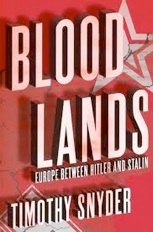“By the end of the war, half the population of Belarus had either been killed or moved.” (Snyder, 251).
One of Timothy Snyder’s most important points is that the destruction of civilian populations was not limited to the holocaust (horrifying though those numbers were). Civilian death in the “Bloodlands” of Belarus, Poland, the Baltics and Ukraine totaled about 14 million, these quite apart from military deaths (but including 5.4 million holocaust deaths).

And the worst place of all to be was Belarus, where it was a matter of chance whether one was dragooned by Nazis or Soviets, a matter of chance whether one’s wife and children were killed by Nazis or Soviet partisans.
But suffering was extreme throughout this region, although different for Jews and non-Jews. When the Soviets returned to Poland as they beat back the Germans, they came as questionable allies to the Poles who had already suffered under them. Surviving Jews could only the see the Red Army as liberators.
The Soviets always underlined that the suffering had been Russian suffering, but the fact of the matter was that the Russian heartland was mostly untouched. Byelorussians, Poles, Baltics, etc. bore the brunt. And it was in the interests of the Soviets to underplay the holocaust.
The Soviets also claimed that the war had started in 1941, not 1939. Thus the territories they occupied in 1939, the Baltics, Eastern Poland and Western Ukraine, were considered always to have been Soviet rather than, as Snyder says, “Booty” of an earlier aggression.
German and Soviet occupation together was worse than German occupation alone.
Snyder reminds us that the majority of dead did not die in concentration camps. The majority were shot, starved to death, or killed on arrival at death camps. He reminds us that the Soviet prisoners of war were starved to death until they became useful as labour, but millions had died before this. As well, Germany planned to starve to death another thirty million people in the Bloodlands, but their plans were stymied by Soviet resistance.
I found this whole semi-forgotten plan of starvation freshly horrifying.
As well, I found it horrifying that the Nazi holocaust death machine only really got rolling once it was clear the Soviets could not be beaten quickly, if at all. For the Nazis, victory was claimed in the killing of the Jews as a stand-in for victory over the Soviets.
There is much more in Snyder than I am summarizing here. I’d just like to add two points which are important.
First, the whole notion of the word “genocide” that I have considered in earlier posts is, according to Snyder, a red herring. It is distracting and unnecessary to fuss over definitions of it (although Naimark devotes a book-length essay to the topic).
His second important point is that one must consider the humanity of all those involved. : “First a legitimate comparison of Nazi Germany and Stalinist Soviet Union must not only explain the crimes but also embrace the humanity of all concerned by them, including the victims, perpetrators, bystanders and leaders. … a legitimate comparison must begin with life rather than death.”
One other thought I’d like to add is that Snyder’s “Bloodlands” include most of the old Polish-Lithuanian Commonwealth, which was partitioned away in 1795. The Bloodlands stand upon a ghost state, one which disappeared but whose old borders delimit the most intense savagery of the war.
This is also the place where the partisan fighting that I depict in my forthcoming novel was most intense. Not only did the war start early in that region, if one includes the Ukrainian famines, it went longer there too, right into the early fifties.
No wonder emigration out of the region has been so great since the collapse of the Soviet Union. When one adds the losses of the first world war in the East to those of the twenty-year period 1933-1953, this must be considered one of the most unhappy places on the Earth.